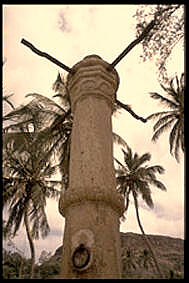|
Figueira Muita and 8 km south of Tarrafal.
Figueira Muita is a settlement in the northern part of the island of Santiago, Cape Verde. It is part of the municipality of Tarrafal. In 2010 its population was 160. It is located about 2 km south of Ribeira da Prata Ribeira da Prata is a townCabo Verde, Statistical Yearboo ... References Villages and settlements in Santiago, Cape Verde Tarrafal Municipality[...More Info...] [...Related Items...] OR: [Wikipedia] [Google] [Baidu] |
Santiago, Cape Verde
Santiago (Portuguese for “ Saint James”) is the largest island of Cape Verde, its most important agricultural centre and home to half the nation's population. Part of the Sotavento Islands, it lies between the islands of Maio ( to the east) and Fogo ( to the west). It was the first of the islands to be settled: the town of Ribeira Grande (now Cidade Velha and a UNESCO World Heritage Site) was founded in 1462. Santiago is home to the nation's capital city of Praia. History The eastern side of the nearby island of Fogo collapsed into the ocean 73,000 years ago, creating a tsunami 170 meters high which struck Santiago. In 1460, António de Noli became the first to visit the island. Da Noli settled at ''Ribeira Grande'' (now Cidade Velha) with his family members and Portuguese from Algarve and Alentejo in 1462.Valor simbóli ... [...More Info...] [...Related Items...] OR: [Wikipedia] [Google] [Baidu] |
Cape Verde
, national_anthem = () , official_languages = Portuguese , national_languages = Cape Verdean Creole , capital = Praia , coordinates = , largest_city = capital , demonym = Cape Verdean or Cabo Verdean , ethnic_groups_year = 2017 , government_type = Unitary semi-presidential republic , leader_title1 = President , leader_name1 = José Maria Neves , leader_title2 = Prime Minister , leader_name2 = Ulisses Correia e Silva , legislature = National Assembly , area_rank = 166th , area_km2 = 4033 , area_sq_mi = 1,557 , percent_water = negligible , population_census = 561,901 , population_census_rank = 172nd , population_census_year = 2021 , population_density_km2 = 123.7 , population_density_sq_mi = 325.0 , population_density_rank = 89th , GDP_PPP ... [...More Info...] [...Related Items...] OR: [Wikipedia] [Google] [Baidu] |
Tarrafal, Cape Verde (municipality)
Tarrafal is a ''concelho'' (municipality) of Cape Verde. It is situated in the northern part of the island of Santiago. Its seat is the town Tarrafal. Its population was 18,565 at the 2010 census, and its area is 120.8 km2. Subdivisions The municipality consists of one ''freguesia'' (civil parish), Santo Amaro Abade. The ''freguesia'' is subdivided into the following settlements (population data from the 2010 census): * Achada Biscanhos (pop: 310) * Achada Lagoa (pop: 64) * Achada Longueira (pop: 520) *Achada Meio (pop: 211) *Achada Moirão (pop: 587) * Achada Tenda (pop: 1,242, town) * Biscainhos (pop: 695) *Chão Bom (pop: 5,166) * Curral Velho (pop: 358) *Fazenda (pop: 107) * Figueira Muita (pop: 160) * Lagoa (pop: 55) * Mato Brasil (pop: 160) *Mato Mendes (pop: 194) * Milho Branco (pop: 165) *Ponta Lobrão (pop: 435) *Ribeira da Prata (pop: 1,009, town) * Tarrafal (pop: 6,656, city) [...More Info...] [...Related Items...] OR: [Wikipedia] [Google] [Baidu] |
Ribeira Da Prata
Ribeira da Prata is a townCabo Verde, Statistical Yearbook 2015 Instituto Nacional de Estatística, p. 32-33 in the northern part of the island of , belonging to the municipality of Tarrafal. In 2010 its population was 1 ... [...More Info...] [...Related Items...] OR: [Wikipedia] [Google] [Baidu] |
Tarrafal, Cape Verde
Tarrafal (also: ''Mangui'' or ''Mangue'') is a cityCabo Verde, Statistical Yearbook 2015 Instituto Nacional de Estatística, p. 32-33 in the northern part of the island of , . In 2010 its population was 6,656. It is a fishing port situated on the northwestern coast. It constitutes the seat of the |
Villages And Settlements In Santiago, Cape Verde
A village is a clustered human settlement or community, larger than a hamlet but smaller than a town (although the word is often used to describe both hamlets and smaller towns), with a population typically ranging from a few hundred to a few thousand. Though villages are often located in rural areas, the term urban village is also applied to certain urban neighborhoods. Villages are normally permanent, with fixed dwellings; however, transient villages can occur. Further, the dwellings of a village are fairly close to one another, not scattered broadly over the landscape, as a dispersed settlement. In the past, villages were a usual form of community for societies that practice subsistence agriculture, and also for some non-agricultural societies. In Great Britain, a hamlet earned the right to be called a village when it built a church. [...More Info...] [...Related Items...] OR: [Wikipedia] [Google] [Baidu] |



